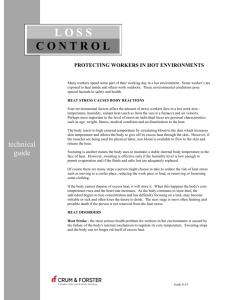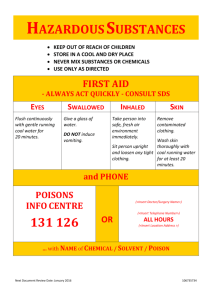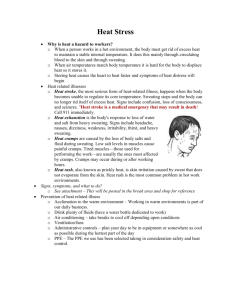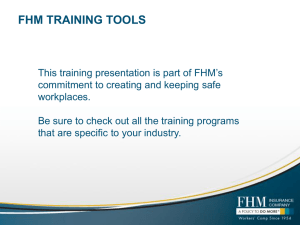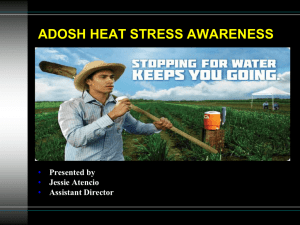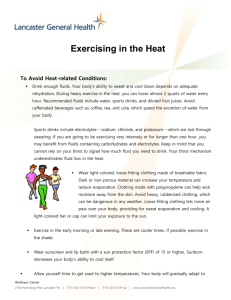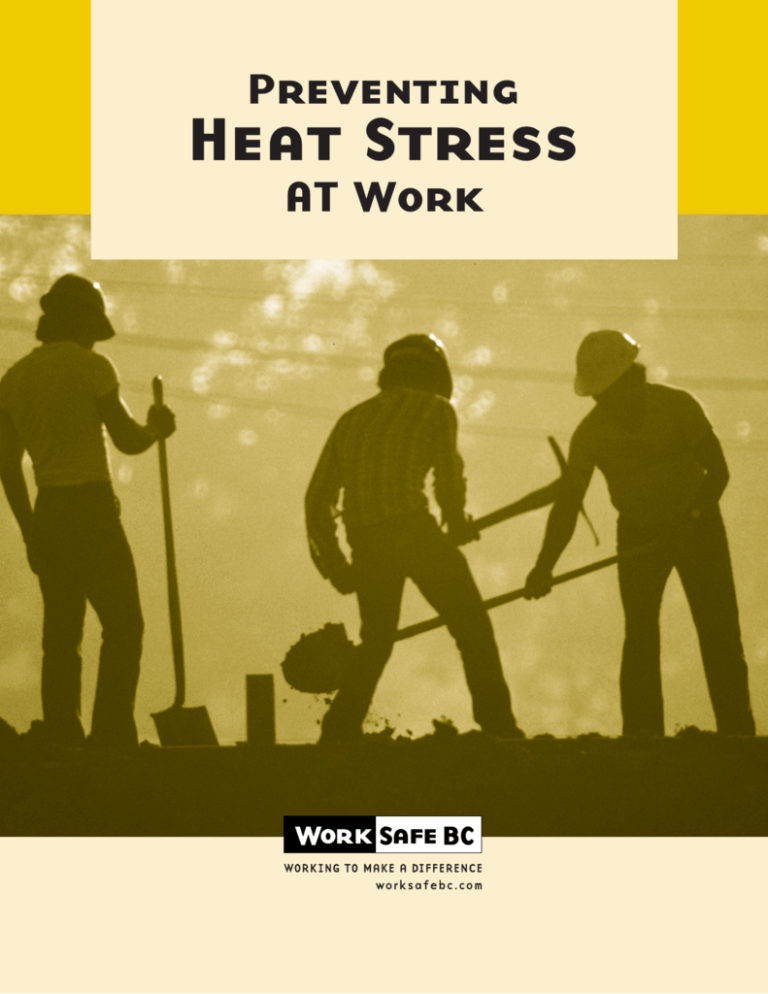
Preventing
Heat Stress
AT Work
About WorkSafeBC
WorkSafeBC (the Workers’ Compensation Board) is an independent provincial statutory agency
governed by a Board of Directors. It is funded by insurance premiums paid by registered employers and
by investment returns. In administering the Workers Compensation Act, WorkSafeBC remains separate
and distinct from government; however, it is accountable to the public through government in its role of
protecting and maintaining the overall well-being of the workers’ compensation system.
WorkSafeBC was born out of a compromise between B.C.’s workers and employers in 1917 where
workers gave up the right to sue their employers or fellow workers for injuries on the job in return
for a no-fault insurance program fully paid for by employers. WorkSafeBC is committed to a safe and
healthy workplace, and to providing return-to-work rehabilitation and legislated compensation benefits
to workers injured as a result of their employment.
WorkSafeBC Prevention Information Line
The WorkSafeBC Prevention Information Line can answer your questions about workplace health
and safety, worker and employer responsibilities, and reporting a workplace accident or incident. The
Prevention Information Line accepts anonymous calls.
Phone 604 276-3100 in the Lower Mainland, or call 1 888 621-7233 (621-SAFE) toll-free in
British Columbia.
To report after-hours and weekend accidents and emergencies, call 604 273-7711 in the Lower Mainland,
or call 1 866 922-4357 (WCB-HELP) toll-free in British Columbia.
Preventing
Heat Stress
AT Work
WorkSafeBC Publications
Many publications are available on the WorkSafeBC web site. The
Occupational Health and Safety Regulation and associated policies and
guidelines, as well as excerpts and summaries of the Workers Compensation
Act, are also available on the web site: WorkSafeBC.com.
Some publications are also available for purchase in print:
Phone: 604 232-9704
Toll-free phone: 1 866 319-9704
Fax: 604 232-9703
Toll-free fax:
1 888 232-9714
Online ordering: WorkSafeBC.com and click on Publications; follow the links for ordering
© 2000, 2005, 2007 Workers’ Compensation Board of British Columbia. All
rights reserved. The Workers’ Compensation Board of B.C. encourages the
copying, reproduction, and distribution of this document to promote health
and safety in the workplace, provided that the Workers’ Compensation
Board of B.C. is acknowledged. However, no part of this publication
may be copied, reproduced, or distributed for profit or other commercial
enterprise, nor may any part be incorporated into any other publication,
without written permission of the Workers’ Compensation Board of B.C.
2007 edition
Library and Archives Canada Cataloguing in Publication Data
Main entry under title:
Preventing heat stress at work. -- [2000] Irregular.
Continues monograph: Heat exposures and heat-related
emergencies.
ISSN 1715-2747 = Preventing heat stress at work
1. Heat - Physiological effect. 2. Heat exhaustion.
3. Heat stroke. 4. Industrial hygiene. I. Workers’
Compensation Board of British Columbia.
RC963.5.H4P73
612'.01446'2
Preventing Heat Stress at Work
- ii -
C00-960213-5
Contents
Introduction................................................................................................ 1
What is heat stress?................................................................................. 2
Primary factors contributing to heat stress..................................... 2
Sources of heat................................................................................. 3
Heat from activity....................................................................... 3
Heat from the environment........................................................ 4
Removal of heat from the body....................................................... 5
Increasing blood flow................................................................. 5
Sweating..................................................................................... 5
Personal risk factors . ...................................................................... 7
Recognizing and treating heat stress...................................................10
Heat cramps....................................................................................10
Signs and symptoms ................................................................10
Treatment .................................................................................10
Heat exhaustion..............................................................................11
Signs and symptoms.................................................................11
Treatment..................................................................................11
Heat stroke......................................................................................12
Signs and symptoms.................................................................12
Treatment..................................................................................12
Preventing heat stress.............................................................................14
Heat stress control plan..................................................................14
Engineering controls.......................................................................15
Administrative controls .................................................................15
Acclimatize workers..................................................................15
Supervise workers.....................................................................16
Determine appropriate work-rest cycles...................................17
Schedule work to minimize heat exposure...............................17
Drink water...............................................................................17
Wear cool clothing.....................................................................18
Personal heat-protective clothing...................................................19
Temperature-controlled clothing.............................................. 20
Anti-radiant heat or reflective clothing.................................... 20
Preventing Heat Stress at Work
- iii -
Introduction
Many jobs require working in hot environments, both outdoors and
indoors. Working in the heat and doing heavy physical work can affect the
body’s cooling system. If the body is unable to cool itself, a worker can
experience heat stress. If heat stress is not recognized and treated in the
early stages, more serious and even fatal conditions may quickly develop.
Workers who are required to work in hot conditions must be adequately
prepared to deal with heat stress. Outdoor work activity often increases
during the hot summer months, particularly in construction, roofing,
forestry, forest fire fighting, and road construction. Indoor work activities
in hot environments expose workers to heat year-round. These include
working in pulp and paper manufacturing, industrial laundries, bakeries,
steel manufacturing and fabricating, boiler rooms, and working near
cement kilns. Workers exposed to hot environments must be trained to
prevent heat stress and to recognize the early symptoms of heat stress in
themselves and co-workers.
Heat stress can result in a range of problems from skin rashes and
light-headedness to convulsions and unconsciousness. Early symptoms
of heat stress — such as excessive fatigue, lethargy, irritability, lack of
co-ordination, and altered judgment — can result in serious accidents.
Unless treated promptly, these symptoms can rapidly develop into serious
conditions, including convulsions and unconsciousness.
This booklet provides a basic overview of risk factors that increase the
chances of suffering from heat stress, how to recognize and treat heat
stress, and how to prevent heat stress. If you work in a hot environment,
this booklet contains information essential to your health and safety.
Preventing Heat Stress at Work
--
What is heat stress?
Human bodies naturally maintain temperatures between 36°C and 38°C.
When the body temperature rises above this range, the body will react
to get rid of the excess heat. However, if the body continues to gain heat
faster than it can get rid of it, the body temperature increases and the
person experiences heat stress. Health problems that result from heat
stress are known as heat disorders. Heat disorders occur most often when
heavy physical work is done in hot, humid environments and when the
body consequently loses too much fluid and salt as sweat.
Many variables contribute to heat stress. To prevent heat stress, workers
and employers must be able to identify all sources of heat and understand
how the body removes excess heat.
Primary factors contributing to heat stress
Environment
Air temperature
Airflow
Humidity
Radiant heat (e.g., sun, kiln)
➡
•
•
•
•
Worker
•
•
•
•
Acclimatization
Hydration
Clothing
Medical
conditions
➡
Heat stress
Preventing Heat Stress at Work
--
➡
If the body is unable
to cool itself, a
worker can experience
heat stress.
Work
•
•
Workload
Work rate
Sources of heat
The body can gain heat in two ways: it can generate heat itself through
work activity, and it can absorb heat from the environment. Both
work activity and the environment are important sources of heat, and
sometimes the work activity itself can be the main source of heat stress.
Cases of heat stress have been reported when the air temperature was
relatively low but the physical activity level of the work was very high.
Heat from activity
The amount of heat generated by the worker (internal heat) depends on
the workload (the level of physical activity). The following table gives
some examples of light, moderate, and heavy workload.
Workload
Light
Moderate
Heavy
Activity
Examples
Sitting, with moderate
movement of arms and legs
Desk work; typing; driving in
light traffic
Standing, doing light work, with
mostly arm movement
Assembly-line work
Casual walking
Supervising a worksite
Brisk walking
Delivering mail
Sitting, with vigorous arm and
leg movement
Driving heavy machinery;
industrial cleaning
Standing, doing light to
moderate work, including some
walking
Picking fruit and vegetables
Moderate lifting or pushing
Warehouse work; loading
and unloading of trucks
Construction tasks
Sawing; planing; digging;
shovelling; sledgehammer
work; roofing
Intermittent heavy lifting,
pushing, or pulling
Restocking shelves;
asbestos removal
Climbing stairs with heavy gear
Firefighting
Preventing Heat Stress at Work
--
Note: These activities do
not take into account heat
from the environment or
protective clothing.
Heat from the environment
The amount of heat gained from the environment (external heat) depends
on the surrounding air temperature, the amount of air movement, and any
radiant heat. Some examples of radiant heat sources are heaters, boilers,
fires, and sunlight. The addition of heat from radiant sources can cause
overheating even when the air temperature is not high.
This illustration
shows examples of
heat sources.
Heat
from air
temperature
Radiant heat
(direct solar)
Radiant heat
(from fire)
Radiant heat
(reflected from
ground)
Preventing Heat Stress at Work
--
Removal of heat from the body
The body can usually get rid of excess heat, but how much heat
is removed depends on several factors such as surrounding air
temperatures, humidity, air flow, clothing, and personal risk factors
(see pages 7–9). If one or more of these factors make it difficult for the
body to get rid of excess heat, heat disorders may develop.
The body has two main ways to get rid of excess heat: by increasing blood
flow to the skin and by sweating.
Increasing blood flow
The bloodstream takes excess body heat to the surface of the body —
that is, to the skin. When the air is cooler than the skin, heat is
transferred to the surrounding air. This process is known as simple
heat exchange by convection. Blood flow increases as excess body heat
increases. Increased blood flow to the skin often causes redness in the
face or a flushed appearance.
In hot weather, shaded areas can provide much cooler air than those in
direct sun. Working or resting in shaded areas allows the body to get rid
of excess heat by transferring it to the surrounding air. If a person is very
hot, taking a cool shower can further speed cooling by transferring body
heat to the cooler water.
Sweating
When the body gets hot, the brain tells the body to sweat. Sweating
itself does not cool the body; the cooling effect occurs when sweat
evaporates from the skin. At air temperatures over 35°C, when the air
is hotter than the skin, sweating becomes the most effective way for the
body to cool itself.
The amount of sweat that evaporates determines the amount of cooling
provided to the body. Therefore, any factor that affects sweating or the
evaporation of sweat will also affect the body’s ability to cool itself by
sweating. Individual workers’ ability to sweat can be reduced by factors
such as not being properly acclimatized to a hot environment, having
a skin condition that limits sweating, using a medication that limits
sweating, and not drinking enough fluids. Evaporation of sweat is affected
Preventing Heat Stress at Work
--
by humidity, airflow, and the type of clothing worn. Low humidity and
high airflow increase evaporation, whereas high humidity and protective
clothing are likely to reduce evaporation. Although protective clothing
protects workers from other hazards, it can contribute to heat stress.
This illustration shows
the three main
sources of heat and
the two main ways
heat is removed from
the body.
Heat
from
sun
Internal heat generated
from work activity
Heat removed
if air is cooler
than skin
Heat added
if air is hotter
than skin
Preventing Heat Stress at Work
--
Heat removed
by sweating
Heat rash
Heat exposure can cause a rash or make existing skin problems worse.
People working in hot, humid conditions may develop a rash that is often
accompanied by intense itching spasms and prickly sensations. This is also
known as prickly heat. Heat rashes are most likely to occur in areas where
clothing traps hot, humid air next to the skin.
Prevention
•Avoid repeated exposure to heat.
•Change clothing often when sweating.
•Wear clean, light-coloured, loose-fitting clothing made of breathable fabric.
Treatment •Leave the hot environment, preferably until the rash has healed.
•Keep the affected areas clean, cool, and dry as much as possible.
Personal risk factors
Since people respond differently to heat, it is important to know the
common risk factors that may increase the chance of a worker developing
heat stress. The two factors that are most important in helping workers to
handle heat are proper acclimatization and physical fitness. With careful
planning, employers can minimize the risk of heat stress by considering
the following factors.
•
Lack of acclimatization. Conditioning of the body to a hot working
environment is known as acclimatization. A person who regularly
works in a hot environment will be at a lower risk of developing
heat disorders than a person who does not. (Acclimatization as a key
preventive measure is discussed further on pages 15–16.)
•
Poor physical fitness. Physically fit people are generally better able to
cope with heat stress and less likely to develop heat disorders. Regular
aerobic activity such as walking, running, cycling, and swimming can
increase a person’s level of physical fitness.
Preventing Heat Stress at Work
--
The two factors that
are most important in
helping workers to
handle heat are
proper acclimatization
and physical fitness.
•
Obesity. Excess fat provides increased insulation, which reduces
heat loss. People with excess weight may also generate more heat
during activity.
•
Increased age. Older workers (40 to 65 years of age) are generally less
able to cope with heat. In older adults, heart function becomes less
efficient, and sweating starts later and occurs at a slower rate.
•
Pre-existing medical conditions or treatments. Some common medical
conditions and treatments can decrease a person’s ability to cope
with heat stress. For example, heart problems and treatments such
as low-salt (low-sodium) diets weaken the body’s ability to efficiently
remove excess heat. Heart disease can also be aggravated by heat.
Other conditions that may increase the risk of heat disorders include
diabetes mellitus, cystic fibrosis, and hyperthyroidism. If there is
any doubt whether an employee is medically able to work in a hot
environment or to do heavy work, seek medical advice from an
occupational health professional.
•
Short-term disorders and minor illnesses. Feverish illnesses, diarrhea,
and vomiting can all cause excess loss of fluids, which may decrease
a person’s ability to cope with heat. Workers who feel unwell should
not work in hot conditions until they feel well again. Sleep deprivation
can also increase the risk of heat stress.
•
Chronic skin disorders. Rashes, dermatitis, healed burns, and other
skin conditions that involve large skin surface areas may limit the
body’s ability to sweat properly. Skin problems can also worsen when
exposed to heat.
•
Use of medication. Some medications that may cause problems when
working in heat stress conditions include:
• Anticholinergic drugs
• Antihistamines
• Antipsychotic phenothiazines
• Beta blockers
• Calcium channel blockers
• Cyclic antidepressants
• Diuretics
• Lithium
• Monoamino oxidase inhibitors
Preventing Heat Stress at Work
--
This list is not complete. People who work in heat stress environments
should discuss the potential side effects of their medications with
their own physician.
•
Alcohol and drugs. Alcohol intake increases water loss, and can cause
even acclimatized workers to become dehydrated. Some street drugs
increase internal body heat and decrease the ability to lose heat.
•
Previous heat stroke. Workers who have previously suffered from heat
stroke are at increased risk for recurrence.
Preventing Heat Stress at Work
--
Recognizing and treating heat stress
Workers should be aware of early signs and symptoms such as excessive
sweating, dizziness, and nausea. If heat stress is not recognized and treated
in the early stages, it can have serious effects on the body, such as heat
cramps, heat exhaustion, or heat stroke, which can be life-threatening.
Heat cramps
Heat cramps are
cured only after the
lost salt has been
replaced.
Heat cramps are painful muscle cramps caused by losing too much salt
through sweating; they are usually the result of heavy exercise or physical
work in a hot environment. Heat cramps usually occur in the muscles
that have been used the most strenuously, such as those in the legs and
abdomen. The cramps typically occur late in a workday or after the
muscles have cooled (for example, during a shower after work).
It is important to distinguish heat cramps from the more common cramps
that occur during strenuous work. Common cramps will be cured with
rest and massage. Heat cramps, in contrast, are cured only after the lost
salt has been replaced.
Signs and symptoms
•
•
Muscular pain or spasms
Excessive sweating
Treatment
•
Move the worker to a cooler environment; if possible, lay the worker
down, and remove or loosen tight-fitting clothing.
• Cool the worker by sponging with cool water and fanning. Take care not
to cool the worker too much. If the worker begins to shiver, stop cooling.
• If the worker is fully alert and not nauseated, provide oral fluids. Juice,
non-caffeinated soft drinks, commercially available oral rehydrating
solutions (sport drinks), or a solution of salt water (1 teaspoon of salt
in one-half litre of water) are best. Alcoholic and caffeinated beverages
are not recommended.
More importantly, continued work under conditions of heat stress can
lead to heat exhaustion, a more serious disorder (see following page). If a
worker has cramps along with other symptoms such as fatigue, weakness,
headache, gastrointestinal illness, or changes in mental state, then the
worker may already be suffering from heat exhaustion or heat stroke.
Preventing Heat Stress at Work
- 10 -
Heat exhaustion
Heat exhaustion is caused by depletion of both water and salt, due to
sweating during prolonged periods of exertion, when fluid replacement
has not been sufficient to match losses. It is more serious than heat
cramps, and the worker will have a number of other signs and symptoms.
Signs and symptoms
•
•
•
•
•
•
•
•
•
Shallow respiration
Increased respiratory rate
Weak rapid pulse
Cool, pale, clammy skin
Sweating
Weakness, fatigue, dizziness
Headache and nausea
Fainting
Muscle cramps
Signs and symptoms are the same as mild shock. The presence of
sweating is an important finding, because it is often the only way to
differentiate heat exhaustion from the life-threatening heat stroke. If
untreated, heat exhaustion may progress to heat stroke. Workers suffering
from heat exhaustion should be transported to medical aid.
Treatment
•
Move the worker to a cooler environment; if possible, lay the worker
down, and remove or loosen tight-fitting clothing.
• Cool the worker by sponging with cool water and fanning. Take care not
to cool the worker too much. If the worker begins to shiver, stop cooling.
• If the worker is fully alert and not nauseated, provide oral fluids. Juice,
non-caffeinated soft drinks, commercially available oral rehydrating
solutions (sport drinks), or a solution of salt water (1 teaspoon of salt
in one-half litre of water) are best. Alcoholic and caffeinated beverages
are not recommended.
In most cases, the patient’s symptoms will improve dramatically within
30 minutes. These patients should still be transported to medical aid.
Preventing Heat Stress at Work
- 11 -
Heat stroke
Heat stroke occurs when the body’s mechanisms for heat dissipation
are overwhelmed and fail. Heat stroke is a life-threatening condition
in which the body’s core temperature rises above 41°C. At core body
temperatures over 41°C sweating stops, and the body is unable to get rid
of heat, causing body temperature to continue to rise. The person’s mental
functions may become disturbed. Without immediate first aid, heat stroke
can result in loss of consciousness, permanent brain damage, and death.
Heat stroke is a
medical emergency!
Notify the first aid
attendant, call 911,
and/or arrange
for immediate
transportation to
medical aid.
Heat stroke can come about relatively quickly or may be preceded by heat
exhaustion (see page 11).
Signs and symptoms
•
•
•
•
•
•
•
•
•
•
•
Hot, dry, flushed skin
Absence of sweating
Agitation, confusion
Decreased level of consciousness
Headache
Nausea and vomiting
Seizures
Increased respiratory rate
Irregular pulse rate
Shock
Cardiac arrest
The presence of hot, dry, flushed skin without any evidence of sweating
is one of the important findings that differentiate heat stroke from other
heat-related illnesses. Heat stroke can occur quickly and without warning.
People should not work alone or unsupervised in conditions that have the
potential to cause heat stress illnesses.
Treatment
•
•
•
Maintain airway, breathing, and circulation as required.
Move the worker to the coolest place available.
Lay the worker down supine (on the back) unless the worker is
actively vomiting or having a seizure. In this situation, place them in
the 3⁄4 prone or lateral (on the side) position.
Preventing Heat Stress at Work
- 12 -
•
Remove all outer clothing, and apply cold water to the worker by
either dousing or applying wet cool sheets. Spraying or sponging the
entire body with cold water is also effective. Fanning will also help.
• If the worker is fully alert and not nauseated, provide oral fluids. Juice,
non-caffeinated soft drinks, commercially available oral rehydrating
solutions (sport drinks), or a solution of salt water (1 teaspoon of salt
in one-half litre of water) are best. Alcoholic and caffeinated beverages
are not recommended.
• Transport the worker to medical aid and continue to cool during
transport.
Preventing Heat Stress at Work
- 13 -
Preventing heat stress
Employers must conduct a heat stress assessment where a worker is,
or may be, exposed to environmental conditions that could cause heat
disorders. If a worker is exposed to such conditions, employers must
develop and implement a heat stress exposure plan. As part of this plan,
employers, supervisors, and workers must have a basic understanding of
how heat affects the body if they are to prevent heat stress.
Employers must provide adequate training and education to all workers
at risk for heat stress, their immediate co-workers, and their supervisors.
Training should include the following information:
Employers must
provide adequate
training and education
to all workers at risk
for heat stress, their
immediate co-workers,
and their supervisors.
•
•
•
•
•
How heat stress develops
Personal risk factors
How to prevent heat stress
How to recognize symptoms
What a worker should do if he or she, or a co-worker, develops a
heat disorder
It is important for workers to recognize the signs and symptoms of the
early stages of heat stress. If workers are able to remove themselves or
co-workers from a hot environment in the early stages, more serious
illness can be avoided. Workers should also be able to recognize the
range of symptoms for different stages of heat stress in themselves and
co-workers. However, since a decrease in alertness is one of the early
symptoms, workers may not be able to recognize the development of heat
stress in themselves.
Heat stress control plan
If a worker is exposed to environmental conditions that could cause heat
disorders, the employer must implement engineering controls to reduce
exposure. If engineering controls are not practical, the employer must
provide administrative controls (such as an appropriate work-rest cycle)
or personal protective equipment if the equipment provides protection
equally effective as administrative controls. Combinations of various control
methods often provide the most effective protection from heat stress.
Preventing Heat Stress at Work
- 14 -
Engineering controls
Engineering controls are the most effective and preferred means to
reduce excessive heat exposure. The following are some examples of
engineering controls.
•
•
•
•
•
Reduce worker activity through automation or mechanization.
Cover or insulate hot surfaces to reduce radiant heat.
Shield workers from radiant heat.
Provide air conditioning or increased ventilation to remove hot air.
Provide fans for spot cooling. (Caution: Where the temperature of
the surrounding air is above 35°C, using fans may actually increase
workers’ risk of heat stress. See “Working in temperatures above
35°C” on page 19 for more information.)
• Reduce the humidity using air conditioning and dehumidifiers, or
reduce the sources of moisture (for example, open water baths, drains,
leaky steam valves).
Administrative controls
If engineering controls are not practicable — which is often the case when
work is done outdoors during the summer months — administrative
controls must be considered. The following are some common
administrative controls used to reduce the risk of heat stress.
Acclimatize workers
The body will adapt to working in hot environments if it is given a chance
to gradually get used to the new conditions. This process, known as
acclimatization, allows the body to modify its own functions to better
cope with heat stress and to remove excess heat more efficiently.
Acclimatization has three main benefits:
•
Enhanced cardiovascular fitness — both heart rate and core body
temperature stay lower when working in a hot environment.
• Enhanced sweating — the person sweats sooner and sweats more,
which has a cooling effect on the body.
• Lower salt content in sweat — this helps to prevent salt depletion.
(Caution: There can still be significant salt loss, because the total
volume of sweat increases.)
Preventing Heat Stress at Work
- 15 -
In general, acclimatized workers will be able to work in hotter work
conditions and for longer periods than unacclimatized workers.
Acclimatize your body
(gradually expose
yourself to heat
and work).
Acclimatization takes time — full acclimatization is usually achieved after
seven continuous days of gradual exposure but can sometimes take as
long as three weeks. The amount of time required for acclimatization is
affected by the same personal risk factors that put individuals at risk for
heat stress (see pages 7–9). For example, an older worker with cardiovascular
disease may need a longer and more gradual acclimatization schedule
than a young, physically fit worker with no known illnesses. Acclimatization
schedules will also vary according to the level of physical work required
and the conditions of the surrounding environment.
The benefits of acclimatization are lost more quickly than they are
gained. In fact, some loss will take place over a weekend away from
work. For this reason, the first workday after a break should require less
demanding work than other days of the week. After seven consecutive
days away from work in a hot environment, a worker is considered to be
unacclimatized. That worker should begin the acclimatization process
from the beginning.
There are some general recommendations for acclimatization schedules.
An average worker who has not previously worked in a hot environment
can start at 20 percent of the full workload on the first day and increase
the workload by 10–20 percent each day. If workers are returning to work
in hot conditions after being away more than seven consecutive days, they
could start at 50 percent of the workload on the first day and increase the
workload by 10–20 percent each day. During the acclimatization period,
it is important to gradually increase the time spent working in the heat at
each workload level.
Supervise workers
Workers should not work alone in conditions where heat stress is
possible. They should be closely supervised or work in pairs or groups to
ensure that heat disorders are identified and treated as soon as possible.
Supervisors need to ensure that there is adequate first aid coverage and
must establish emergency procedures to deal with serious conditions such
as heat exhaustion and heat stroke.
Preventing Heat Stress at Work
- 16 -
Determine appropriate work-rest cycles
Appropriate work-rest cycles should be determined and scheduled to
allow adequate time for workers’ bodies to cool. Workers cannot rely on
their bodies to indicate when a rest period is needed. By the time a worker
feels ill, it may be too late.
It is important to have cool areas, such as shaded or well-ventilated areas,
for breaks and rests. Showering or soaking in cool water, when possible,
can cool the body very quickly.
Schedule work to minimize heat exposure
Common sense should be used to schedule and organize work to
minimize heat exposure.
•
•
•
•
•
•
Schedule the hardest physical tasks for the coolest part of the day.
Rotate work activities or use additional workers to reduce heat
exposure for each member of the work crew.
Allow for slower-paced work during the hottest periods of the day.
Move or relocate the work away from direct sunlight or radiant heat
sources whenever possible.
For outside work, schedule routine maintenance and repair work
during cooler seasons of the year.
For inside work, schedule routine maintenance and repair work for
time when hot operations are shut down.
Drink water
The body naturally sweats to cool itself. Sweating can use up a significant
amount of fluid, which must be replaced continuously throughout
the workday. If fluid is not regularly replaced, a worker will become
dehydrated, increasing his or her risk for heat stress.
It is important to drink water (without added salt) before as well as during
and after work in a hot environment. As a starting point, workers should
drink about two glasses (1⁄ 2 litre) of water before starting work in a hot
environment and one glass every 20 minutes throughout the workday. In
very hot environments or where sweating is profuse, even more water may
be required. Workers must not wait until they are thirsty to replace fluids.
Preventing Heat Stress at Work
- 17 -
Workers should not
work alone in
conditions where heat
stress is possible.
To replace the salt
lost by sweating,
workers can eat salty
foods. Salt tablets are
not recommended.
Employers are required
to provide an adequate
supply of cool drinking
water close to the work
area for workers exposed
to heat. Suitable drinks
include tap water, mineral
water, and fruit juices. Fluids
do not need to be iced; cooled
drinks between 10°C–15°C are
adequate. Fluids that contain
caffeine or alcohol are not
suitable because they increase
dehydration. Eating fresh fruits
will also help to replace lost fluids.
Although the average North American diet
usually contains enough salt for most work
conditions, working in hot environments can
cause salt deficiencies. To replace the salt lost
by sweating, workers can eat salty foods. Salt
tablets are not recommended.
Wear cool clothing
Clothing suitable for hot conditions and heavy work helps the body to
cool itself. Loose-fitting clothes made from fabrics such as cotton and silk
allow air to pass through. Air passing over the skin will help cool the body
by evaporating the sweat from the skin.
For work outside in the sun, light-coloured clothing reflects the heat
better than dark-coloured clothing and helps to keep the body cool.
Large-brimmed hats worn on hot sunny days provide shade for the head,
face, and neck area. If safety headgear such as a hard hat is required,
attaching a piece of light-coloured fabric to the back and side rim of the
hat will provide shade for much of the neck area. Items attached to hard
hats must not affect the integrity of the hard hat — for example, do not
use glue or drill holes.
Preventing Heat Stress at Work
- 18 -
Wool clothing can help to minimize heat stress for work near radiant
heat sources (such as boilers and kilns) and where the air temperature is
higher than 35°C. Wool clothing deflects radiant heat away from the skin
while allowing sweat to evaporate. In very hot climates with a lot of direct
sun exposure, outdoor workers often wear wool hats to keep cool.
Working in temperatures above 35°C
A thin layer of air is always trapped next to the skin. When the air temperature
is greater than the skin temperature (skin temperature is generally about
35°C), this trapped layer of air protects the skin from direct contact with the
hotter air in the environment. Air movement from fans or wind at these high
temperatures can strip away this protective layer of air and cause the body
to be heated by the warmer air. This is known as convective heating. (This
is basically how convection ovens work to cook food faster.) Wearing a light
layer of loose-fitting clothing helps to maintain this protective layer of air.
This is why in hot desert climates people cover themselves in clothing from
head to toe.
Personal heat-protective clothing
Some work environments may be so hot that even the most suitable and
acclimatized workers will be able to work only for short periods of time or
only with the use of personal temperature-controlled equipment.
In extremely hot environments — for example, near kilns — specialized
heat-protective clothing may be required. This type of protective
clothing can also be used in moderately hot environments to allow
longer work periods between breaks. A proper assessment of all heat
sources is required to determine which, if any, specialized clothing
would be effective in reducing heat stress. Specialized heat-protective
clothing should be worn only by properly trained workers following the
manufacturer’s instructions. Heat-protective clothing may not provide
a complete solution to the problem of heat stress, so precautions such
as close supervision should be maintained until the effectiveness of the
clothing is known.
Preventing Heat Stress at Work
- 19 -
Wear clean, lightcoloured, loose-fitting
clothing made of
breathable fabric.
There are two main types of specialized heat-protective clothing:
temperature-controlled clothing and anti-radiant heat or
reflective clothing.
Temperature-controlled clothing
Various types of temperature-controlled clothing are available, including
air-cooled suits, water-cooled suits, and ice-cooled waistcoats. There are
some practical limitations on the use of such equipment, especially when
access to the working area is restricted.
Anti-radiant heat or reflective clothing
Anti-radiant heat or reflective clothing may be necessary where there
is excessive radiant heat from a hot surface that cannot be otherwise
covered or shielded (for example, from a boiler). This clothing is available
in different forms, varying from aprons and jackets to suits that will
completely cover the worker from the neck to the feet. Anti-radiant heat
and reflective clothing protects only against radiant heat and provides
little or no protection from high air temperatures unless the clothing is
also temperature-controlled.
Key points to prevent heat stress
1. Learn to recognize the signs and symptoms of heat stress in yourself
and co-workers. Avoid working alone.
2. Acclimatize your body (gradually expose yourself to heat and work).
3. Drink plenty of water (one glass every 20 minutes). Avoid caffeine,
alcohol, and drugs.
4. Wear clean, light-coloured, loose-fitting clothing made of
breathable fabric.
5. Take rest breaks in a cool or well-ventilated area. Take more breaks
during the hottest part of the day or when doing hard physical work.
Allow your body to cool down before beginning again.
6. Schedule work to minimize heat exposure. Do the hardest physical work
during the coolest part of the day.
Preventing Heat Stress at Work
- 20 -
WorkSafeBC Offices
Visit our web site at WorkSafeBC.com.
Abbotsford
2774 Trethewey Street V2T 3R1
Phone 604 276-3100
1 800 292-2219
Fax 604 556-2077
North Vancouver
400 – 224 Esplanade Ave. W. V7M 1A4
Phone 604 276-3100
1 888 875-6999
Fax 604 232-1558
Burnaby
450 – 6450 Roberts Street V5G 4E1
Phone 604 276-3100
1 888 621-7233
Fax 604 232-5950
Prince George
1066 Vancouver Street V2L 5M4
Phone 250 561-3700
1 800 663-6623
Fax 250 561-3710
Coquitlam
104 – 3020 Lincoln Avenue V3B 6B4
Phone 604 276-3100
1 888 967-5377
Fax 604 232-1946
Surrey
100 – 5500 152 Street V3S 5J9
Phone 604 276-3100
1 888 621-7233
Fax 604 232-7077
Courtenay
801 30th Street V9N 8G6
Phone 250 334-8765
1 800 663-7921
Fax 250 334-8757
Terrace
4450 Lakelse Avenue V8G 1P2
Phone 250 615-6605
1 800 663-3871
Fax 250 615-6633
Kamloops
321 Battle Street V2C 6P1
Phone 250 371-6003
1 800 663-3935
Fax 250 371-6031
Victoria
4514 Chatterton Way V8X 5H2
Phone 250 881-3418
1 800 663-7593
Fax 250 881-3482
Kelowna
110 – 2045 Enterprise Way V1Y 9T5
Phone 250 717-4313
1 888 922-4466
Fax 250 717-4380
Head Office / Richmond
Prevention Information Line:
Phone 604 276-3100
1 888 621-7233 (621-SAFE)
Nanaimo
4980 Wills Road V9T 6C6
Phone 250 751-8040
1 800 663-7382
Fax 250 751-8046
Nelson
524 Kootenay Street V1L 6B4
Phone 250 352-2824
1 800 663-4962
Fax 250 352-1816
Administration:
6951 Westminster Highway
Phone 604 273-2266
Mailing Address:
PO Box 5350 Stn Terminal
Vancouver BC V6B 5L5
After Hours
Health & Safety Emergency
604 273-7711
1 866 922-4357 (WCB-HELP)
R06/06
R02/07
Printed in Canada
BK30

